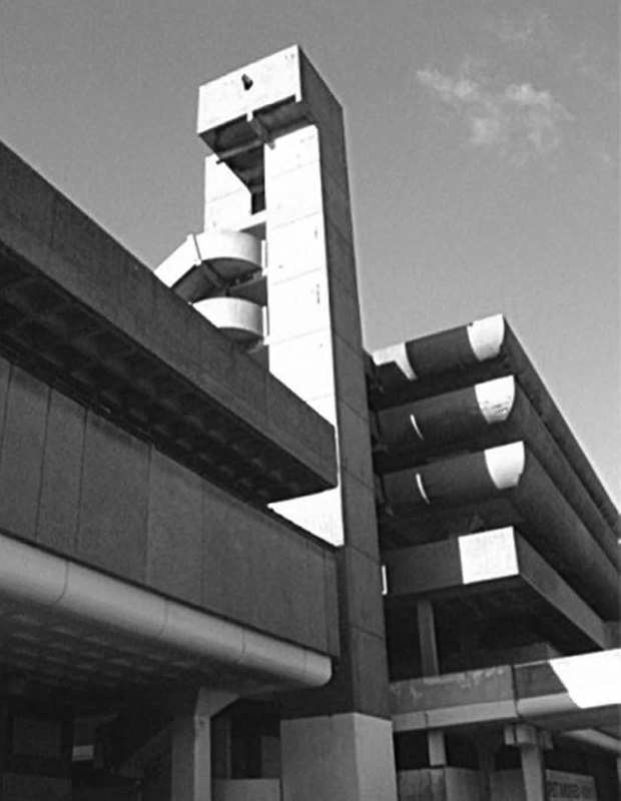The style known as brutalism was a bold, distinctive version of modernism that became popular in the 1960s. Typified by extensive use of concrete and strong, block-like forms, it was used widely in many types of large buildings, from university campuses to housing schemes. Criticized by many for their grim inhumanity, the brutalist buildings are still admired by numerous architects and conservationists.
By the end of the Second World War modernist architecture had developed in various ways and through various channels, from the drama of Russian constructivism to the pure machine aesthetic of the Bauhaus. Reconstruction after the war brought huge opportunities for architects, and the 1950s and 1960s saw the construction of more modernist concrete buildings than the interwar years when modernism developed.
Blocks and concrete
Several of the most famous early modernists, such as Le Corbusier and Ludwig Mies van der Rohe, were still active, and Le Corbusier in particular was designing buildings that excited post-war architects. Among his projects that became especially famous were his Unité d’Habitation, a vast apartment block in Marseilles that included shops, a crèche and other facilities, and his buildings for Chandigarh, the new capital of the Punjab in India.
One thing that impressed about these buildings was their marked, rectilinear geometry and strong block-like appearance. In structures such as the High Court at Chandigarh, large overhanging concrete roofs, projecting side walls of concrete and rows of recessed windows produced this blocky effect, which was enhanced by the strong Indian sunlight.
CIAM
CIAM (les Congrès Internationaux d’Architecture Moderne) was an international body providing a forum for architects to discuss their art. It began in the 1920s and its conferences became a key meeting place for modernist architects. Heavily influenced by the ideas of Le Corbusier, CIAM promoted architecture based on function and on social and economic factors. It thus played a key role in promoting modernism in its early decades. CIAM also had a strong influence on the brutalist generation through the 1933 Athens Charter. This advocated high-rise apartment blocks with green spaces around them and zoned cities, with green areas between zones devoted to housing, work, recreation and transport.
Another feature of this architect’s work in this period was his way of using poured concrete. The material was formed in wooden molds, and when the timber was removed the patterns of the grain were left exposed on the surface of the concrete. Le Corbusier called this material béton brut (“raw concrete”).
Modern grandeur
This combination of béton brut and a blocklike design seemed to offer a way of using the materials of modernism to design buildings on a large scale, to create a sense of grandeur in a modern idiom. Such buildings could be imposing and dramatic, while also giving the surface of the concrete visual interest. The style seemed well suited to the type of apartment blocks, office towers, shopping centers and multistorey car parks that were needed in reconstructed Europe. It also suited university campuses in both Europe and America.
“‘The warehouse aesthetic’ [was] a very fair description of what The New Brutalism stood for in its first phase.” Rayner Banham, “The New Brutalism” in A Critic Writes: Selected Essays
Prominent exponents of the style included the British husband-and-wife team Alison and Peter Smithson, Ernö Goldfinger, Sir Denys Lasdun, William Meyer, the Scottish firm of Gillespie, Kidd & Coia and the American firm Walker and McGough.
Public misgivings
Although brutalism was popular among architects and planners, it did not always meet with the approval of the public. There were several reasons for this. Block-like concrete façades that looked well in the light of India or the South of France did not suit northern light so well, and concrete that started out clean quickly began to look gray and grubby. In addition, in the post-war climate of rapid reconstruction, many brutalist buildings were poorly constructed.
Perhaps the greatest problem was with the use of brutalism in housing schemes. Inspired by Le Corbusier’s Unité d’Habitation, many architects and planners laid out concrete housing schemes on a large scale. These schemes usually exploited fashionable planning theories that separated cars and pedestrians, providing access to flats via elevated walkways. They packed in hundreds, sometimes thousands of flats, often next to green spaces and incorporated the latest in modern technology.
But the pedestrian “streets in the sky” became the haunts of muggers, poor maintenance turned the flats into dingy slums, the green spaces became windy wastelands and the modern conveniences broke down. Many such housing schemes became bywords for deprivation and brutalism seemed uncannily well named.
A source of controversy
Critics of brutalism, such as the Prince of Wales, have attacked both the uncompromising design of the buildings and the depressing living environment these structures often provide. As a result many brutalist buildings have had a short life, but conservation groups have campaigned against the demolition of notable examples, such as Plymouth’s Tricorn Centre and the outstanding St. Peter’s Seminary.
Brutalism or new brutalism?
These two terms are often used interchangeably for the concrete architecture of the 1960s and 1970s. But some architectural critics distinguish between the two, using “brutalism” to mean the strictly zoned planning and high-rise blocks advocated by CIAM, and “new brutalism” to describe the béton brut architecture described by Rayner Banham in his book The New Brutalism (1966), practiced by the Smithsons and others, and exemplified by Plymouth’s Tricorn Centre (below).

Meanwhile some brutalist buildings, especially university buildings from Yale to Chicago, have survived because they are well-designed structures fit for their purpose. The Johnson Art Museum at Cornell University, Ithaca, New York, designed in a dramatic brutalist style by I.M. Pei is a case in point. Such structures demonstrate that, in spite of the disasters, the better example of Brutalism will survive.